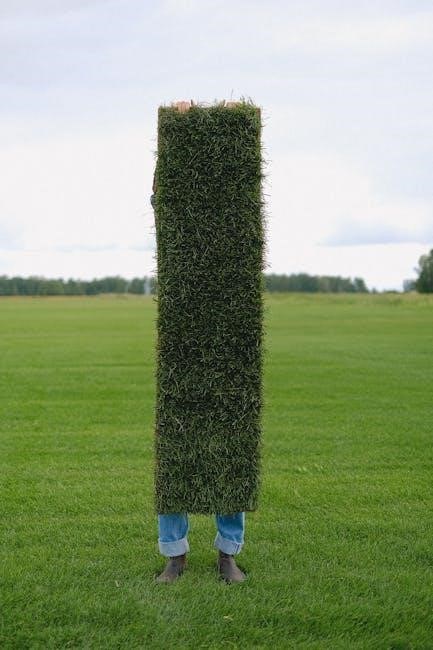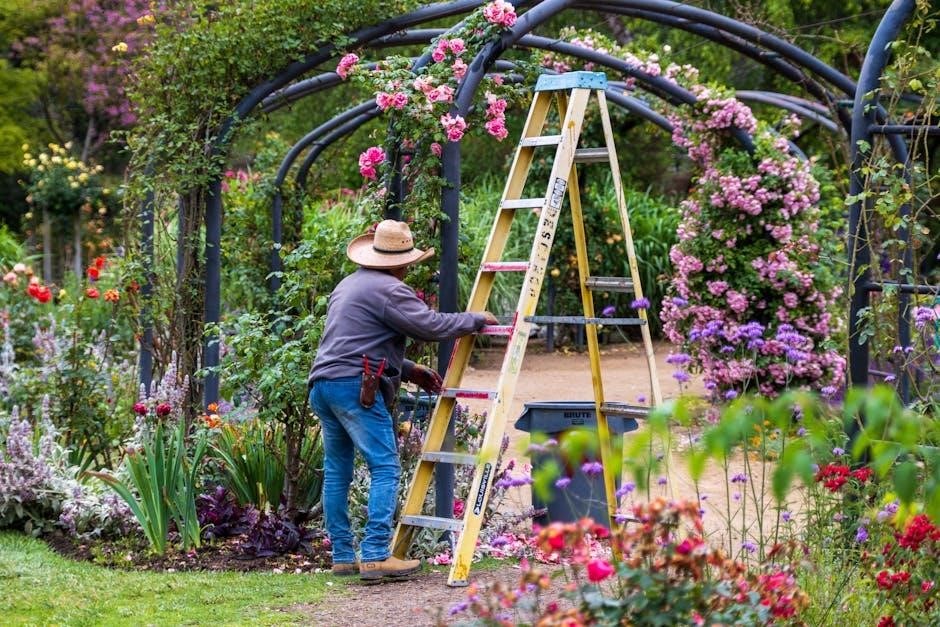A landscape maintenance checklist is an essential tool for ensuring vibrant, healthy outdoor spaces. It streamlines daily, weekly, and seasonal tasks, promoting consistency and curb appeal.

Importance of Regular Landscape Maintenance
Importance of Regular Landscape Maintenance
Regular landscape maintenance is crucial for preserving the aesthetic appeal and health of outdoor spaces. It prevents small issues like overgrowth or debris buildup from becoming major problems. By following a checklist, property owners can ensure consistent care, enhancing curb appeal and property value. Proper maintenance also supports plant health, reducing the risk of pests and diseases. Regular upkeep fosters safety by removing hazards like fallen branches and uneven terrain. Additionally, it promotes environmental sustainability by managing water use and soil quality. A well-maintained landscape not only beautifies the space but also protects investments in plants, hardscapes, and equipment. Consistency is key to achieving these benefits.
Benefits of Using a Checklist
Using a landscape maintenance checklist offers numerous benefits, including enhanced organization and accountability. It ensures no task is overlooked, whether daily, weekly, or seasonal. A checklist streamlines maintenance processes, allowing property owners and professionals to track progress efficiently. By breaking tasks into manageable categories, it reduces overwhelm and ensures consistency. Customizable templates cater to specific needs, such as irrigation checks or pest control. Checklists also facilitate communication among team members, ensuring everyone is aligned. Regular use promotes a well-maintained, visually appealing landscape, protecting investments in plants, hardscapes, and equipment. Downloadable PDF versions, like those from Lumiform, provide convenient access to comprehensive, actionable plans. This tool is invaluable for maintaining outdoor spaces effectively.

Daily Landscape Maintenance Tasks
Daily tasks involve inspecting plants, watering, and removing debris. These routine checks ensure healthy growth and a tidy appearance, forming the foundation of a thriving landscape.
Inspecting Plants for Health
Inspecting plants daily ensures early detection of issues like pests, diseases, or nutrient deficiencies. Check leaves, stems, and flowers for discoloration, wilting, or unusual growth.
Look for signs of stress, such as yellowing leaves or droopy branches, which may indicate overwatering or underwatering. Ensure soil moisture is balanced, and prune dead or damaged areas promptly.
Watering and Irrigation Checks
Regular watering and irrigation checks are crucial for plant health. Ensure systems are functioning properly, with no leaks or blockages, to maintain consistent moisture levels.
Adjust irrigation schedules seasonally to match weather conditions, avoiding overwatering, which can harm plants and waste resources. Check soil moisture by hand or with sensors to confirm water penetration and prevent root rot.
Removing Debris and Leaves
Removing debris and leaves is a vital part of landscape maintenance. Regularly clear leaves, branches, and other debris to maintain the beauty and health of your outdoor space. Use tools like rakes, leaf blowers, or manual pickup to ensure thorough removal. This task prevents debris from smothering grass and plants, while also reducing the risk of pests and diseases. Check flower beds, lawns, and hardscapes for accumulated debris. Dispose of collected material properly to keep your environment clean and sustainable. Incorporate this task into your daily or weekly checklist to maintain a pristine and well-maintained landscape. A clean yard not only looks better but also promotes plant growth and safety.

Weekly Landscape Maintenance Tasks
Perform mowing, trimming, and pruning to maintain neatness. Check for pests, diseases, and inspect garden beds. Keep your landscape healthy and visually appealing with consistent weekly care.
Mowing and Trimming Grass
Mowing and trimming are critical weekly tasks for a well-manicured lawn. Maintain grass at the recommended height to promote health and prevent weed growth. Use sharp blades to ensure clean cuts, which help grass heal quickly and resist diseases. Trimming around trees, gardens, and hard surfaces keeps the landscape looking tidy. Regular mowing also encourages even growth and prevents overgrown areas. Check your mower and trimmer for proper function before use and schedule maintenance as needed. A consistent mowing schedule ensures your lawn remains vibrant and visually appealing throughout the growing season.
Pruning Shrubs and Trees
Pruning shrubs and trees is a weekly task that enhances their health and appearance. Remove dead, diseased, or damaged branches to prevent the spread of disease and encourage new growth. Use clean, sharp tools to make precise cuts, which help plants heal quickly. Prune shrubs to maintain shape and promote air circulation, reducing the risk of pests and diseases. For trees, focus on removing lower branches and thinning overcrowded areas to improve sunlight penetration. Regular pruning also improves the visual appeal of your landscape and ensures safety by removing hazardous branches. Keep track of pruning needs with a checklist to maintain consistent care for your plants.
Checking for Pests and Diseases
Regularly inspecting plants for pests and diseases is crucial for maintaining healthy landscapes. Look for signs like discoloration, holes in leaves, or unusual growth. Common pests include aphids, spider mites, and scale, while diseases like powdery mildew or root rot can harm plants. Early detection prevents infestations from spreading. Use clean tools to avoid transferring pests or diseases between plants. Consider organic or chemical treatments based on severity. Keep a checklist to track inspections and treatments, ensuring consistent monitoring. Prompt action protects plant health and preserves the beauty of your outdoor space. Regular checks also help identify nutrient deficiencies or environmental stressors affecting plant well-being.
Inspecting Garden Beds
Regularly inspecting garden beds ensures their health and appearance. Check for weeds, soil compaction, and proper mulch levels. Look for signs of pests or diseases, such as discoloration or unusual growth. Ensure plants are spaced correctly and receiving adequate sunlight and water. Remove dead or dying plants to prevent the spread of disease. Check for erosion or drainage issues, especially after heavy rain. Use a checklist to document findings and schedule necessary repairs or treatments. Mulch replenishment and edging maintenance are also key tasks. Regular inspections help maintain the aesthetic and functional integrity of garden beds, ensuring they remain vibrant and well-kept throughout the year.

Monthly Landscape Maintenance Tasks
Monthly tasks keep landscapes thriving. Fertilize plants, inspect soil conditions, and apply mulch to retain moisture and suppress weeds. Regularly check irrigation systems for efficiency and leaks.
Fertilizing Plants
Fertilizing is a crucial monthly task for maintaining healthy, vibrant plants. Use a balanced fertilizer (e.g., 10-10-10) to replenish soil nutrients, promoting growth and color. Always follow package instructions to avoid over-fertilizing, which can harm plants and the environment. Test soil pH annually to determine nutrient needs. Apply fertilizers during early morning or late afternoon to minimize evaporation. For seasonal plants, adjust fertilizer types—e.g., high-phosphorus for blooming plants. Organic options like compost or manure can enhance soil health naturally. Keep records of fertilization dates and types to track plant responses. Avoid fertilizing during extreme weather, as this can stress plants. Proper fertilization ensures thriving landscapes and sustainable growth.
Inspecting Soil Conditions
Regular soil inspections are vital for maintaining healthy plant growth. Check soil moisture by inserting a finger into the soil up to the knuckle or using a moisture meter. Test soil pH annually using DIY kits or professional lab services to ensure it suits your plants. Monitor nutrient levels, especially nitrogen, phosphorus, and potassium, to avoid deficiencies. Look for signs of erosion or compaction, which can hinder root growth. Adjust soil conditions based on test results, such as adding organic matter to improve structure. Proper soil care prevents drainage issues and promotes root health, ensuring plants thrive. Schedule inspections monthly during the growing season for optimal results.
Applying Mulch
Mulching is a key part of landscape maintenance, offering benefits like weed suppression, soil temperature regulation, and moisture retention. Spread mulch evenly around plants, keeping it a few inches away from stems to prevent rot. Aim for a 2-3 inch layer, replenishing as needed. Choose organic options like wood chips or bark for nutrient-rich soil improvement. Inorganic mulches, such as gravel, are better for decorative purposes. Apply mulch after watering and during cooler parts of the day to reduce evaporation. Maintain mulched areas monthly to ensure proper coverage and prevent material breakdown. Regular mulching enhances curb appeal and supports plant health, making it a simple yet effective maintenance practice for any landscape.
Checking Irrigation Systems
Regular irrigation system checks are crucial for efficient water use and plant health. Inspect sprinklers, drip lines, and hoses for leaks, blockages, or damage. Adjust sprinkler heads to avoid over-spray onto sidewalks or buildings. Test timers and sensors to ensure they operate correctly, especially after seasonal changes. Clean filters and replace worn-out parts promptly. Schedule annual professional inspections for complex systems to optimize performance. Proper irrigation maintenance prevents water waste, reduces utility bills, and ensures plants receive adequate hydration. Include irrigation checks in your monthly and seasonal landscape maintenance routines for a lush, sustainable landscape throughout the year. Consistent monitoring ensures your irrigation system functions efficiently, supporting healthy plant growth and resource conservation.
Seasonal Landscape Maintenance
Adapt your maintenance routine to each season to ensure a vibrant, resilient landscape. Tailor tasks like planting, pruning, and cleanup to match seasonal needs for optimal results.

Spring Landscape Preparation
Spring is a critical season for revitalizing your landscape. Start by clearing winter debris, inspecting and repairing hardscapes, and checking irrigation systems for damage. Fertilize plants and apply fresh mulch to garden beds. Prune shrubs and trees to promote healthy growth and remove dead branches. Inspect lawn areas for winter damage and apply seed or sod where necessary. Check for pests and diseases that may have emerged during the winter. Finally, prepare gardening tools and equipment for the upcoming growing season. A spring-specific checklist ensures all tasks are completed efficiently, setting your landscape up for success year-round.
Summer Lawn Care Tips
During the summer, maintaining your lawn’s health is crucial. Regular mowing at the recommended height for your grass type prevents stress and promotes even growth. Water deeply but infrequently to encourage deep root development, making your lawn more drought-resistant. Fertilize with a slow-release formula to provide nutrients throughout the season. Monitor for pests like grubs or chinch bugs and treat promptly if necessary. Inspect irrigation systems to ensure proper coverage and avoid overwatering. Lastly, maintain sharp mower blades to prevent tearing the grass, which can lead to disease. Consistent care during summer ensures a lush, vibrant lawn that withstands heat and activity.
Fall Cleanup and Maintenance
Fall cleanup is essential for preparing your landscape for winter and ensuring a healthy start in spring. Clear leaves and debris from lawns, gardens, and hardscapes to allow sunlight to reach the grass and prevent moisture buildup. Inspect and trim branches of trees and shrubs to remove deadwood and promote airflow. Prepare garden beds by dividing perennials, adding compost, and applying mulch to retain moisture and regulate soil temperature. Check irrigation systems for damage or leaks and winterize them to prevent freezing. Finally, protect sensitive plants from frost and ensure your landscape is tidy before winter. Regular fall maintenance ensures your outdoor space remains resilient and vibrant year-round.
Winter Protection for Plants
Protecting plants during winter is crucial for their survival and health. Apply mulch around plant bases to insulate soil and retain moisture. Use tree bags or anti-desiccant sprays on evergreens to prevent drying winds. Bring potted plants indoors or move them to sheltered locations. Install snow fencing to shield plants from heavy snowdrifts. Water newly planted trees and shrubs during winter droughts to keep roots hydrated. Remove snow carefully from branches to avoid damage. Finally, avoid over-pruning in fall to prevent new growth that may not harden before winter. These protective measures ensure plants thrive when spring arrives. Regular checks during winter also help address any emerging issues promptly. Proper care now guarantees a vibrant landscape next season.

Tools and Equipment Maintenance
Regularly clean and sharpen gardening tools to ensure efficiency and prevent damage. Inspect and service equipment like mowers and trimmers to maintain performance. Store tools properly to prolong lifespan.
Maintaining Gardening Tools
Proper tool maintenance is crucial for efficiency and longevity. Sharpen blades regularly to ensure clean cuts and prevent plant damage. Sanitize tools with bleach or alcohol to avoid spreading diseases. Store tools in dry areas to prevent rust and corrosion. Lubricate moving parts to keep equipment functioning smoothly. Regularly inspect for wear and tear and replace broken or damaged components. Organize tools in a designated area for easy access. These practices ensure tools remain reliable and effective, supporting your landscape maintenance efforts throughout the year.
Inspecting and Servicing Equipment
Regular inspection and servicing of equipment are vital for optimal performance and longevity. Check tires, brakes, and hydraulic systems for proper function and wear. Inspect blades and cutting edges for sharpness and damage, ensuring they are securely attached. Test engine performance and ensure all moving parts are well-lubricated. Replace filters and fluids according to manufacturer schedules. Store equipment in a clean, dry environment to prevent rust and corrosion. Schedule professional servicing annually to address complex issues. Keeping equipment in top condition ensures efficiency and reliability for landscape maintenance tasks throughout the year.

Additional Tips and Resources
Enhance your landscape maintenance routine by downloading a landscape maintenance checklist PDF from trusted sources like Lumiform or local gardening experts. Utilize digital tools for tracking tasks and customizing templates to suit your needs, ensuring consistency and efficiency in upkeep.
Downloading a Landscape Maintenance Checklist PDF
Downloading a landscape maintenance checklist PDF offers a structured approach to managing outdoor spaces efficiently. These checklists, available from sources like Lumiform, provide detailed tasks for daily, weekly, and seasonal maintenance. They often include sections for inspecting plants, watering schedules, and equipment upkeep. Customizable templates allow users to tailor tasks to their specific needs, ensuring no detail is overlooked. Many checklists also feature tips for enhancing curb appeal and prolonging equipment lifespan. by incorporating these resources, property owners and professionals can streamline their maintenance routines, ensuring landscapes remain healthy and visually appealing year-round. Downloading such a guide is a practical step toward achieving consistency and excellence in landscape care.
Customizing Your Checklist
Customizing your landscape maintenance checklist is crucial for tailoring it to your property’s unique needs. Start by identifying specific tasks relevant to your outdoor space, such as plant species, soil types, and local climate conditions. Many downloadable PDF templates, like those from Lumiform, allow users to add or remove sections, ensuring the checklist remains relevant. Incorporate seasonal tasks, such as winter plant protection or fall cleanup, and include reminders for equipment maintenance. By personalizing the checklist, you can prioritize tasks effectively, ensuring no aspect of your landscape is overlooked. This customization not only enhances efficiency but also helps maintain the aesthetic and health of your outdoor environment throughout the year.
Using Digital Tools for Maintenance Tracking
Digital tools are revolutionizing landscape maintenance tracking, offering streamlined solutions for property managers and homeowners. Platforms like Lumiform provide customizable digital checklists that can be accessed via mobile devices, enabling real-time updates and seamless task monitoring. These tools eliminate the need for static PDFs, allowing users to track progress dynamically. Features such as automated reminders, photo documentation, and analytics help maintain consistency and accountability. By integrating digital tools, landscapers can efficiently manage workflows, reduce errors, and ensure all tasks are completed on schedule. This modern approach not only enhances productivity but also supports sustainable and organized landscape care, making it easier to achieve professional-level results.
Final Thoughts on Effective Landscape Maintenance
Effective landscape maintenance requires consistency, attention to detail, and a proactive approach. By using a comprehensive checklist, you can ensure all tasks are completed efficiently, from daily inspections to seasonal preparations. Regular maintenance not only enhances the beauty of your outdoor spaces but also promotes plant health and environmental sustainability. Tools like downloadable PDF checklists simplify the process, making it easier to stay organized and track progress. Remember, a well-maintained landscape is a long-term investment in your property’s value and aesthetic appeal. Stay consistent, and enjoy the rewards of a vibrant, thriving outdoor environment year-round.
Encouragement to Stay Consistent
Consistency is key to achieving a well-maintained landscape. Regular tasks, no matter how small, add up over time to create a beautiful, healthy outdoor space. By sticking to your checklist, you’ll prevent issues like overgrown plants or irrigation problems. Break tasks into manageable steps to avoid feeling overwhelmed. Celebrate small victories, like a perfectly mowed lawn or vibrant flower beds, to stay motivated. Remember, consistent effort leads to long-term results, enhancing your property’s curb appeal and value. Stay committed, and enjoy the pride and satisfaction of a thriving landscape year-round.
